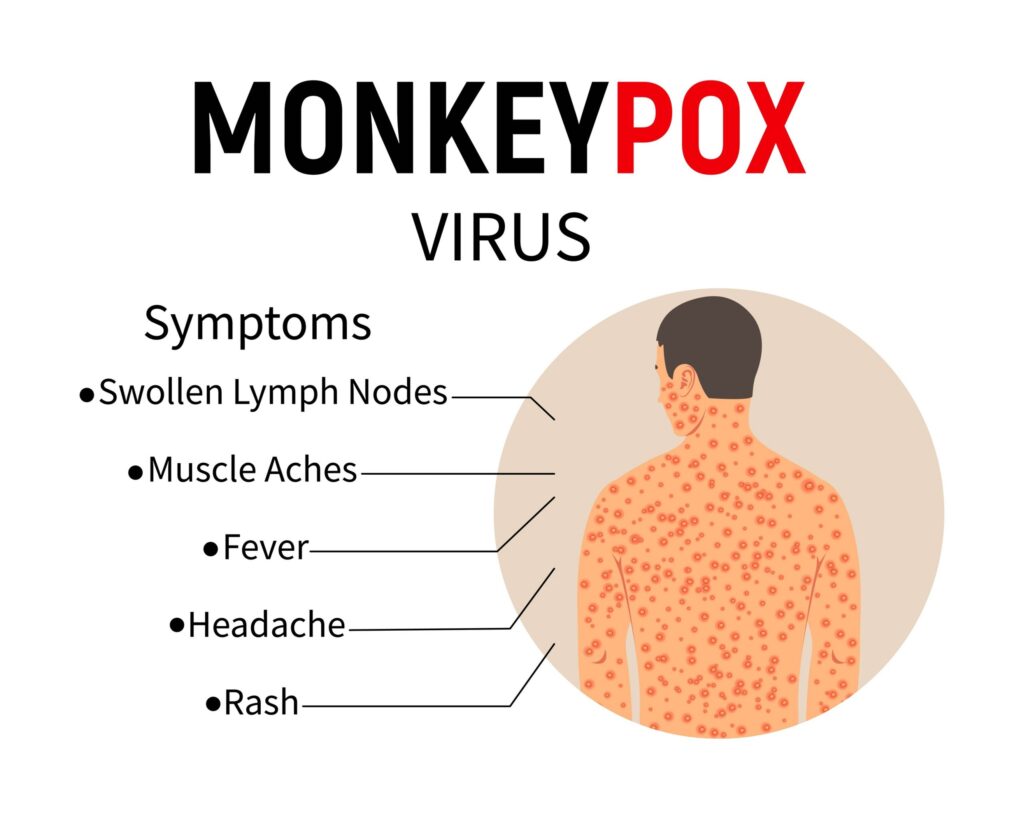
Monkeypox, also known as mpox, is a rare viral disease caused by the monkeypox virus, which belongs to the same family of viruses as smallpox. It primarily spreads from animals to humans through direct contact with the blood, bodily fluids, or skin lesions of infected animals. Human-to-human transmission can occur via respiratory droplets, direct contact with body fluids or lesions, and contaminated materials like bedding. The disease typically begins with symptoms such as fever, headache, muscle aches, and swollen lymph nodes, followed by a rash that progresses through several stages, including macules, papules, vesicles, pustules, and scabs. The incubation period ranges from 5 to 21 days, and symptoms usually last for 2 to 4 weeks. While there is no specific treatment for monkeypox, supportive care and symptom management are essential, and vaccines used for smallpox may offer some protection. Preventive measures include avoiding contact with potentially infected animals, practicing good hygiene, and using personal protective equipment.
Monkeypox, caused by the orthopoxvirus mpox, has symptoms similar to those of smallpox, but less severe.
What is Mpox?
The virus that causes monkeypox is the infectious disease known as mpox. It shares a virus family with smallpox, a more serious illness that was declared extinct in the 1980s. Clade Ib, a novel mpox virus type, is raising concerns since it may spread more widely and affect a wider range of age groups, including young infants.
The mpox virus is not selective. Anybody who is exposed to the virus has the potential to get infected, and pregnant women, immunocompromised people, and children are more vulnerable to serious illness.
Complications from MPOEX can also affect children who are underweight or who suffer from other medical conditions.
What are the symptoms of Monkeypox?
The symptoms usually last 2 to 4 weeks and often resolve without treatment. Following are the common symptoms:
- Fever: Often the first symptom.
- Headache: Persistent and severe.
- Muscle aches and backache.
- Fatigue and chills.
- Swollen lymph nodes: Known as lymphadenopathy.
- Rash: Appears 1 to 3 days after the fever, starting on the face and then spreading to other parts of the body, including the palms, soles, and genitalia. The rash progresses through several stages: macules, papules, vesicles, pustules, and finally scabs.
Symptoms usually appear 5 to 21 days after exposure and often improve on their own within 2 to 4 weeks. You should self-isolate at home as long as you have not had a high temperature for at least 72 hours, you have not had new blisters in the previous 48 hours, and all your blisters are crusted. You should also avoid contact with other people until all your sores have faded.
How does the mpox virus spread?
The mpox virus causes mpox. The virus spreads through close contact with an infected animal or person. It can also be spread when a person handles materials such as blankets that have come into contact with someone with mpox. The mpox virus is spread from person to person by:
Direct contact with skin rash, scabies, or body fluids of a person with mpox. Prolonged close contact (more than four hours) with respiratory droplets from an infected person. This includes sexual contact. Clothing, sheets, blankets, or other materials that have come into contact with the skin rash or body fluids of an infected person. An infected pregnant woman can transmit the Mpox virus to a fetus. Mpox is transmitted from an animal to a person by:
Bites or scratches from an animal. Wild game cooked for consumption. Products, such as leather or fur, made from infected animals. Direct contact with body fluids or rashes of animals infected with mpox.
What is the treatment for MPOX?
- Treatment for most people with MPOX is aimed at relieving symptoms. Care may include managing the skin damage caused by the MPOX rash, drinking enough fluids to help keep stools soft, and managing the pain.
- If you have MPOX, isolate yourself at home in a separate room from family and pets until the rash and scabies heal.
- There is no specific approved treatment for MPOX. Healthcare professionals can treat chickenpox with certain antiviral medications used to treat chickenpox, such as tecovirimat (TPOXX) or brincidofovir (Tembexa).
- For people who are unlikely to react to the vaccine, a health professional can offer vaccinia immunoglobulin. These contain antibodies from people who have received the smallpox vaccine.
What can I do to avoid contracting or spreading the Monkeypox (MPOX) virus?
Follow these steps to prevent MPOX infection or the spread of the MPOX virus:
- Avoid close contact with people who have a rash similar to MPOX. Avoid handling clothes, sheets, blankets or other materials that have come into contact with an infected animal or person.
- Isolate people with MPOX from healthy people.
- Wash hands thoroughly with soap and water after contact with an infected person or animal. If soap and water are not available, use an alcohol-based hand sanitizer.
- Avoid animals that can carry the virus.
- Some smallpox vaccines can prevent smallpox, including the ACAM2000 and Jynneos vaccines. These vaccines can be used to prevent smallpox because smallpox and chickenpox are caused by related viruses.
- Health professionals may suggest that people who have been exposed to smallpox get vaccinated. Some people who are at risk of exposure to the virus through their work, such as laboratory workers, can also be vaccinated.
- The CDC does not recommend that everyone get the mpox vaccine at this time.
